Dependence of Charpy Impact Properties of Fe-30Mn-0.05C Steel on Microstructure
Abstract
1. Introduction
2. Materials and Methods
3. Results
3.1. Initial Microstructure Characterization
3.2. Mechanical Properties
4. Discussion
4.1. Hardness Analysis of Impact Specimens
4.2. Fracture Mechanisms of Fe-30Mn-0.05C Steel
4.2.1. Fractography of Impacted Specimens
4.2.2. Microstructure Characterization after Impact Tests
4.3. Effect of Initial Microstructure on Charpy Impact Energy
5. Conclusions
Author Contributions
Funding
Data Availability Statement
Acknowledgments
Conflicts of Interest
References
- Tang, L.; Wang, L.; Wang, M.; Liu, H.; Kabra, S.; Chiu, Y.; Cai, B. Synergistic deformation pathways in a TWIP steel at cryogenic temperatures: In situ neutron diffraction. Acta Mater. 2020, 200, 943–958. [Google Scholar] [CrossRef]
- Li, Y.; Lu, Y.; Li, W.; Khedr, M.; Liu, H.; Jin, X. Hierarchical microstructure design of a bimodal grained twinning-induced plasticity steel with excellent cryogenic mechanical properties. Acta Mater. 2018, 158, 79–94. [Google Scholar] [CrossRef]
- Sohn, S.; Hong, S.; Lee, J.; Suh, B.; Kim, S.; Lee, B.; Kim, N.; Lee, S. Effects of Mn and Al contents on cryogenic-temperature tensile and Charpy impact properties in four austenitic high-Mn steels. Acta Mater. 2015, 100, 39–52. [Google Scholar] [CrossRef]
- Wang, Y.; Zhang, Y.; Godfrey, A.; Kang, J.; Peng, Y.; Wang, T.; Hansen, N.; Huang, X. Cryogenic toughness in a low-cost austenitic steel. Commun. Mater. 2021, 2, 44. [Google Scholar] [CrossRef]
- Hany, S.; Milochova, M.; Littrell, K.; Lorange, R.; Vogt, J.; Abi-Aad, E.; Bychkov, E. Advanced characterization of cryogenic 9Ni steel using synchrotron radiation, neutron scattering and 57Fe Mössbauer spectroscopy. Mater. Des. 2018, 146, 219–227. [Google Scholar] [CrossRef]
- Mallick, P.; Tewary, N.; Ghosh, S.; Chattopadhyay, P. Effect of cryogenic deformation on microstructure and mechanical properties of 304 austenitic stainless steel. Mater. Charact. 2017, 133, 77–86. [Google Scholar] [CrossRef]
- Zhang, L.; Wen, M.; Imade, M.; Fukuyama, S.; Yokogawa, K. Effect of nickel equivalent on hydrogen gas embrittlement of austenitic stainless steels based on type 316 at low temperatures. Acta Mater. 2008, 56, 3414–3421. [Google Scholar] [CrossRef]
- Sharma, D.K.; Filipponi, M.; Di Schino, A.; Rossi, F.; Castaldi, J. Corrosion behaviour of high temperature fuel cells: Issues for materials selection. Metalurgija 2019, 58, 347–351. [Google Scholar]
- Zhang, D.; Zhang, J.; Kuang, J.; Liu, G.; Sun, J. Superior strength-ductility synergy and strain hardenability of Al/Ta co-doped NiCoCr twinned medium entropy alloy for cryogenic applications. Acta Mater. 2021, 220, 117288. [Google Scholar] [CrossRef]
- Zhang, D.; Zhang, J.; Kuang, J.; Liu, G.; Sun, J. The B2 phase-driven microstructural heterogeneities and twinning enable ultrahigh cryogenic strength and large ductility in NiCoCr-based medium-entropy alloy. Acta Mater. 2022, 233, 117981. [Google Scholar] [CrossRef]
- Choi, J.; Lee, S.; Park, Y.; Han, I.; Morris, J. High manganese austenitic steel for cryogenic applications. In Proceedings of the Twenty-Second International Offshore and Polar Engineering Conference, Rhodes, Greece, 17–22 June 2012. [Google Scholar]
- Ren, J.; Chen, Q.; Chen, J.; Liu, Z. Role of vanadium additions on tensile and cryogenic-temperature charpy impact properties in hot-rolled high-Mn austenitic steels. Mater. Sci. Eng. A 2021, 811, 141063. [Google Scholar] [CrossRef]
- Kim, B.; Lee, S.; Kim, D.; Jo, Y.; Bae, J.; Sohn, S.; Lee, S. Effects of Ni and Cu addition on cryogenic-temperature tensile and Charpy impact properties in austenitic 22Mn-0.45C-1Al steels. J. Alloy. Compd. 2020, 815, 152407. [Google Scholar] [CrossRef]
- Lee, S.; Kim, B.; Jo, M.; Kim, K.; Lee, J.; Bae, J.; Lee, B.; Sohn, S.; Lee, S. Effects of Cr addition on Charpy impact energy in austenitic 0.45C-24Mn-(0,3,6)Cr steels. J. Mater. Sci. Technol. 2020, 50, 21–30. [Google Scholar] [CrossRef]
- Curtze, S.; Kuokkala, V. Dependence of tensile deformation behavior of TWIP steels on stacking fault energy, temperature and strain rate. Acta Mater. 2010, 58, 5129–5141. [Google Scholar] [CrossRef]
- Li, C.; Li, K.; Dong, J.; Wang, J.; Shao, Z. Mechanical behaviour and microstructure of Fe-20/27Mn–4Al-0.3C low magnetic steel at room and cryogenic temperatures. Mater. Sci. Eng. A 2021, 809, 140998. [Google Scholar] [CrossRef]
- Chen, J.; Dong, F.; Liu, Z.; Wang, G. Grain size dependence of twinning behaviors and resultant cryogenic impact toughness in high manganese austenitic steel. J. Mater. Res. Technol. 2021, 10, 175–187. [Google Scholar] [CrossRef]
- Xie, P.; Shen, S.; Wu, C.; Li, J.; Chen, J. Unusual relationship between impact toughness and grain size in a high-manganese steel. J. Mater. Sci. Technol. 2021, 89, 122–132. [Google Scholar] [CrossRef]
- Ren, J.; Chen, Q.; Chen, J.; Liu, Z. Enhancing strength and cryogenic toughness of high manganese TWIP steel plate by double strengthened structure design. Mater. Sci. Eng. A 2020, 786, 139397. [Google Scholar] [CrossRef]
- Chen, J.; Dong, F.; Jiang, H.; Liu, Z.; Wang, G. Influence of final rolling temperature on microstructure and mechanical properties in a hot-rolled TWIP steel for cryogenic application. Mater. Sci. Eng. A 2018, 724, 330–334. [Google Scholar] [CrossRef]
- Xiong, J.; Wang, Y.; Zhang, Y.; Wang, T.; Peng, Y.; Godfrey, A.; Hansen, N.; Huang, X. Tailoring the microstructure to enhance the cryogenic mechanical properties of a Fe-34.5Mn-0.04C steel. Mater. Sci. Eng. A 2022, 853, 143769. [Google Scholar] [CrossRef]
- De Cooman, B.; Estrin, Y.; Kim, S. Twinning-induced plasticity (TWIP) steels. Acta Mater. 2018, 142, 283–362. [Google Scholar] [CrossRef]
- Zhu, Y.; Ameyama, K.; Anderson, P.; Beyerlein, I.; Gao, H.; Kim, H.; Lavernia, E.; Mathaudhu, S.; Mughrabi, H.; Ritchie, R.; et al. Heterostructured materials: Superior properties from hetero-zone interaction. Mater. Res. Lett. 2021, 9, 1–31. [Google Scholar] [CrossRef]
- Liu, Y.; Cao, Y.; Mao, Q.; Zhou, H.; Zhao, Y.; Jiang, W.; Liu, Y.; Wang, J.; You, Z.; Zhu, Y. Critical microstructures and defects in heterostructured materials and their effects on mechanical properties. Acta Mater. 2020, 189, 129–144. [Google Scholar] [CrossRef]
- Lu, W.; Luo, X.; Ning, D.; Wang, M.; Yang, C.; Li, M.; Yang, Y.; Li, P.; Huang, B. Excellent strength-ductility synergy properties of gradient nano-grained structural CrCoNi medium-entropy alloy. J. Mater. Sci. Technol. 2022, 112, 195–201. [Google Scholar] [CrossRef]
- Kang, J.; Wang, Y.; Chen, X.; Zhang, C.; Peng, Y.; Wang, T. Grain refinement and mechanical properties of Fe-30Mn-0.11C steel. Results Phys. 2019, 13, 102247. [Google Scholar] [CrossRef]
- Shintani, T.; Murata, Y. Evaluation of the dislocation density and dislocation character in cold rolled Type 304 steel determined by profile analysis of X-ray diffraction. Acta Mater. 2011, 59, 4314–4322. [Google Scholar] [CrossRef]
- Zhong, S.; Xu, C.; Li, Y.; Li, W.; Luo, H.; Peng, R.; Jia, X. Hierarchy modification induced exceptional cryogenic strength, ductility and toughness combinations in an asymmetrical-rolled heterogeneous-grained high manganese steel. Int. J. Plast. 2022, 154, 103316. [Google Scholar] [CrossRef]
- Huang, X. Tailoring dislocation structures and mechanical properties of nanostructured metals produced by plastic deformation. Scr. Mater. 2009, 60, 1078–1082. [Google Scholar] [CrossRef]
- Bai, Y.; Kitamura, H.; Gao, S.; Tian, Y.; Park, N.; Park, M.; Adachi, H.; Shibata, A.; Sato, M.; Murayama, M.; et al. Unique transition of yielding mechanism and unexpected activation of deformation twinning in ultrafine grained Fe-31Mn-3Al-3Si alloy. Sci. Rep. 2021, 11, 15870. [Google Scholar] [CrossRef]
- Liu, M.; Gong, W.; Zheng, R.; Li, J.; Zhang, Z.; Gao, S.; Ma, C.; Tsuji, N. Achieving excellent mechanical properties in type 316 stainless steel by tailoring grain size in homogeneously recovered or recrystallized nanostructures. Acta Mater. 2022, 226, 117629. [Google Scholar] [CrossRef]
- Wang, Y.; Kang, J.; Peng, Y.; Wang, T.; Hansen, N.; Huang, X. Laminated Fe-34.5 Mn-0.04C composite with high strength and ductility. J. Mater. Sci. Technol. 2018, 34, 1939–1943. [Google Scholar] [CrossRef]
- Gutierrez-Urrutia, I.; Raabe, D. Grain size effect on strain hardening in twinning-induced plasticity steels. Scr. Mater. 2012, 66, 992–996. [Google Scholar] [CrossRef]
- Gao, J.; Jiang, S.; Zhang, H.; Huang, Y.; Guan, D.; Xu, Y.; Guan, S.; Bendersky, L.; Davydov, A.; Wu, Y.; et al. Facile route to bulk ultrafine-grain steels for high strength and ductility. Nature 2021, 590, 262–267. [Google Scholar] [CrossRef]
- Wang, Y.; Kang, J.; Peng, Y.; Wang, T.; Hansen, N.; Huang, X. Hall-Petch strengthening in Fe-34.5Mn-0.04C steel cold-rolled, partially recrystallized and fully recrystallized. Scr. Mater. 2018, 155, 41–45. [Google Scholar] [CrossRef]
- Yang, M.; Zhou, L.; Wang, C.; Jiang, P.; Yuan, F.; Ma, E.; Wu, X. High impact toughness of CrCoNi medium-entropy alloy at liquid-helium temperature. Scr. Mater. 2019, 172, 66–71. [Google Scholar] [CrossRef]
- Zhang, X. Exploring high strength metallic materials: A lesson from pearlitic steel wire. IOP Conf. Ser. Mater. Sci. Eng. 2019, 89, 012058. [Google Scholar] [CrossRef]
- Feng, H.; Cai, L.; Wang, L.; Zhang, X.; Fang, F. Microstructure and strength in ultrastrong cold-drawn medium carbon steel. J. Mater. Sci. Technol. 2022, 97, 89–100. [Google Scholar] [CrossRef]
- Chen, S.; Hu, J.; Zhang, X.; Dong, H.; Cao, W. High Ductility and Toughness of a Micro-duplex Medium-Mn Steel in a Large Temperature Range from -196 °C to 200 °C. J. Iron Steel Res. Int. 2015, 22, 1126–1130. [Google Scholar] [CrossRef]
- Zhang, X.; Godfrey, A.; Winther, G.; Hansen, N.; Huang, X. Plastic deformation of submicron-sized crystals studied by in-situ Kikuchi diffraction and dislocation imaging. Mater. Charact. 2012, 70, 21–27. [Google Scholar] [CrossRef]
- Pan, H.; He, Y.; Zhang, X. Interactions between dislocations and boundaries during deformation. Materials 2021, 14, 1012. [Google Scholar] [CrossRef]
- Liang, Z.; Luo, Z.; Huang, M. Temperature dependence of strengthening mechanisms in a twinning-induced plasticity steel. Int. J. Plast. 2019, 116, 192–202. [Google Scholar] [CrossRef]
- Rahman, K.; Vorontsov, V.; Dye, D. The effect of grain size on the twin initiation stress in a TWIP steel. Acta Mater. 2015, 89, 247–257. [Google Scholar] [CrossRef]
- Gutierrez-Urrutia, I.; Zaefferer, S.; Raabe, D. The effect of grain size and grain orientation on deformation twinning in a Fe-22wt.% Mn-0.6wt.% C TWIP steel. Mater. Sci. Eng. A 2010, 527, 3552–3560. [Google Scholar] [CrossRef]
- Mohammadzadeh, R.; Mohammadzadeh, M. Inverse grain size effect on twinning in nanocrystalline TWIP steel. Mater. Sci. Eng. A 2019, 747, 265–275. [Google Scholar] [CrossRef]
- Wang, Z.; Lu, W.; An, F.; Song, M.; Ponge, D.; Raabe, D.; Li, Z. High stress twinning in a compositionally complex steel of very high stacking fault energy. Nat. Commun. 2022, 13, 3598. [Google Scholar] [CrossRef]
- Kang, S.; Jung, J.; Kang, M.; Woo, W.; Lee, Y. The effects of grain size on yielding, strain hardening, and mechanical twinning in Fe-18Mn-0.6C-1.5Al twinning-induced plasticity steel. Mater. Sci. Eng. A 2016, 652, 212–220. [Google Scholar] [CrossRef]
- Ueji, R.; Tsuchida, N.; Terada, D.; Tsuji, N.; Tanaka, Y.; Takemura, A.; Kunishige, K. Tensile properties and twinning behavior of high manganese austenitic steel with fine-grained structure. Scr. Mater. 2008, 59, 963–966. [Google Scholar] [CrossRef]
- Ghasri-Khouzani, M.; McDermid, J. Microstructural evolution and mechanical behaviour of Fe-30Mn-C steels with various carbon contents. Mater. Sci. Technol. 2017, 33, 1159–1170. [Google Scholar] [CrossRef]
- Luo, Q.; Wang, H.; Li, G.; Sun, C.; Li, D.; Wan, X. On mechanical properties of novel high-Mn cryogenic steel in terms of SFE and microstructural evolution. Mater. Sci. Eng. A 2019, 753, 91–98. [Google Scholar] [CrossRef]
- Park, J.; Lee, K.; Sung, H.; Kim, Y.; Kim, S.; Kim, S. J-Integral Fracture Toughness of High-Mn Steels at Room and Cryogenic Temperatures. Metall. Mater. Trans. A 2019, 50, 2678–2689. [Google Scholar] [CrossRef]
- Haase, C.; Barrales-Mora, L.; Roters, F.; Molodov, D.; Gottstein, G. Applying the texture analysis for optimizing thermomechanical treatment of high manganese twinning-induced plasticity steel. Acta Mater. 2014, 80, 327–340. [Google Scholar] [CrossRef]
- Gutierrez-Urrutia, I.; Raabe, D. Dislocation and twin substructure evolution during strain hardening of an Fe-22wt.% Mn-0.6wt.% C TWIP steel observed by electron channeling contrast imaging. Acta Mater. 2011, 59, 6449–6462. [Google Scholar] [CrossRef]
- Ashby, M.; Embury, J. The influence of dislocation density on the ductile-brittle transition in BCC metals. Scr. Mater. 1985, 19, 557–562. [Google Scholar] [CrossRef]
- Bouaziz, O.; Allain, S.; Scott, C.; Cugy, P.; Barbier, D. High manganese austenitic twinning induced plasticity steels: A review of the microstructure properties relationships. Curr. Opin. Solid State Mater. Sci. 2011, 15, 141–168. [Google Scholar] [CrossRef]
- Byun, T.; Hashimoto, N.; Farrell, K. Temperature dependence of strain hardening and plastic instability behaviors in austenitic stainless steels. Acta Mater. 2004, 52, 3889–3899. [Google Scholar] [CrossRef]
- Wang, P.; Ren, J.; Chen, Q.; Chen, J.; Liu, Z. Effect of secondary twins on strain hardening behavior of a high manganese austenitic steel at 77 K by quasi in situ EBSD. Mater. Charact. 2021, 180, 111428. [Google Scholar] [CrossRef]
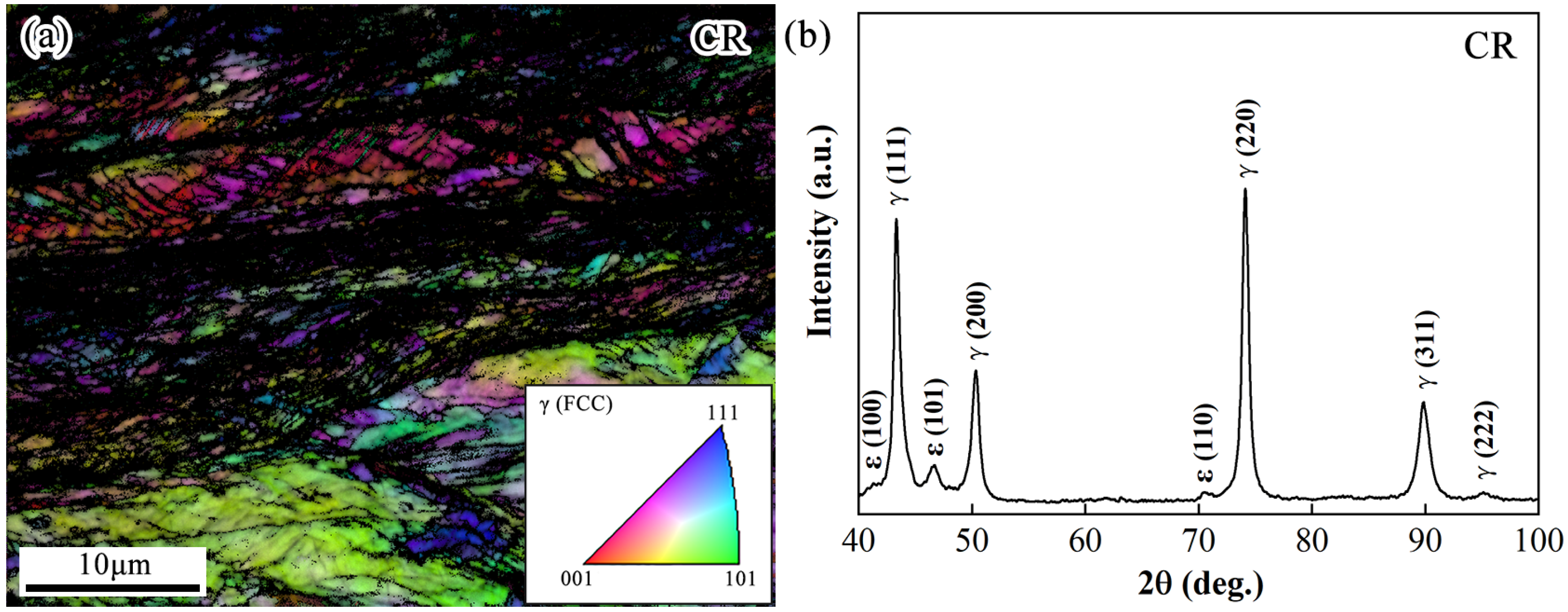
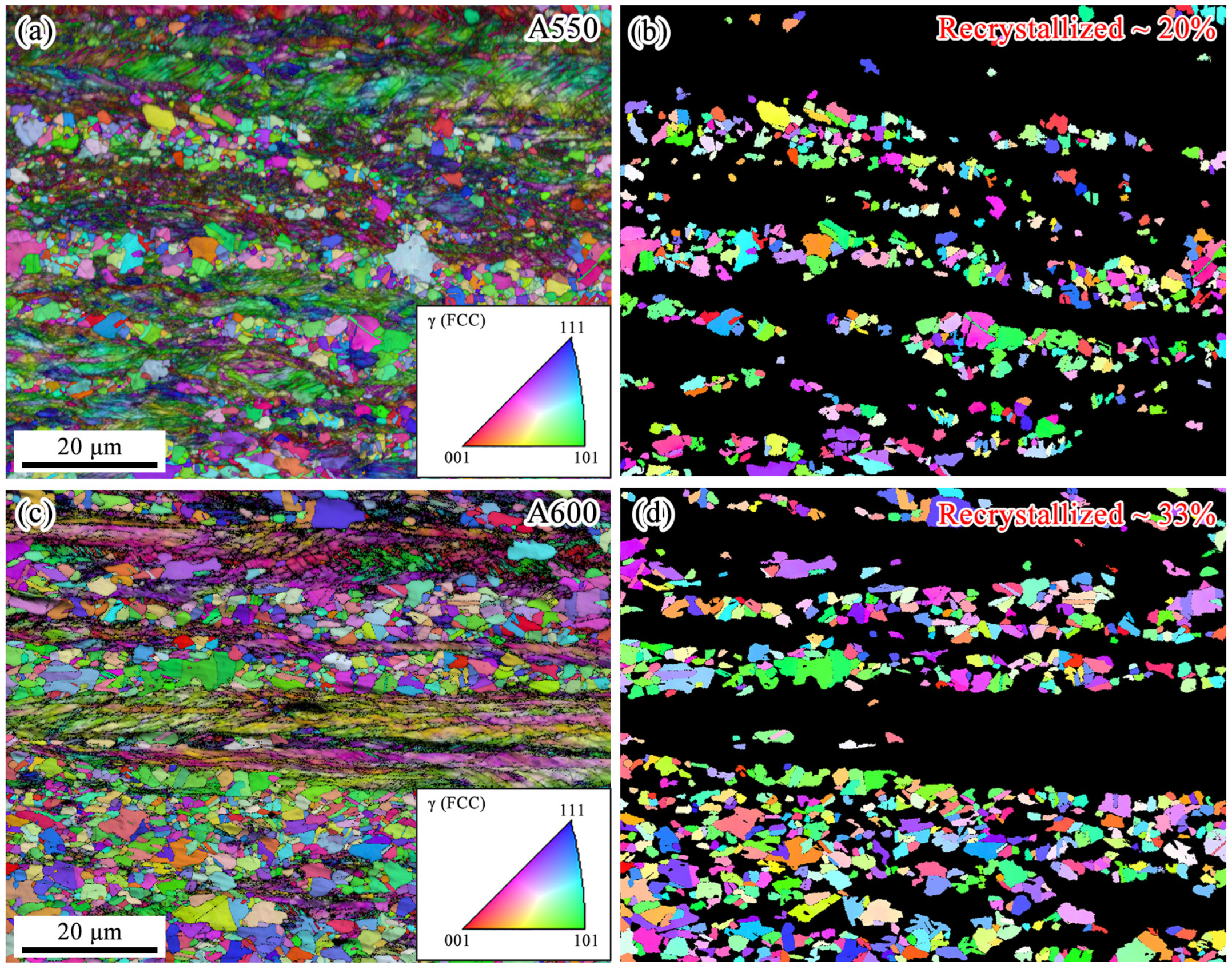


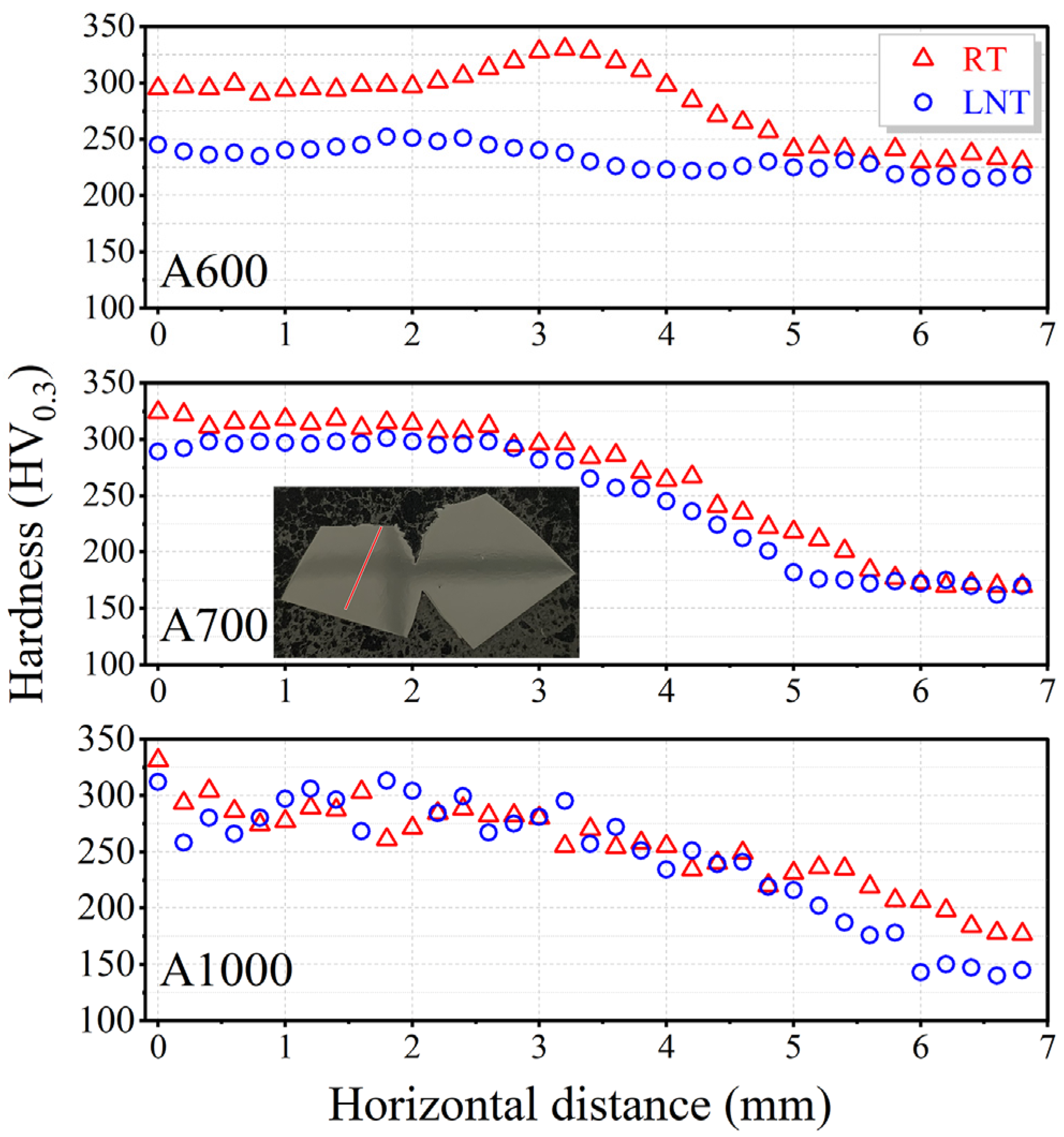
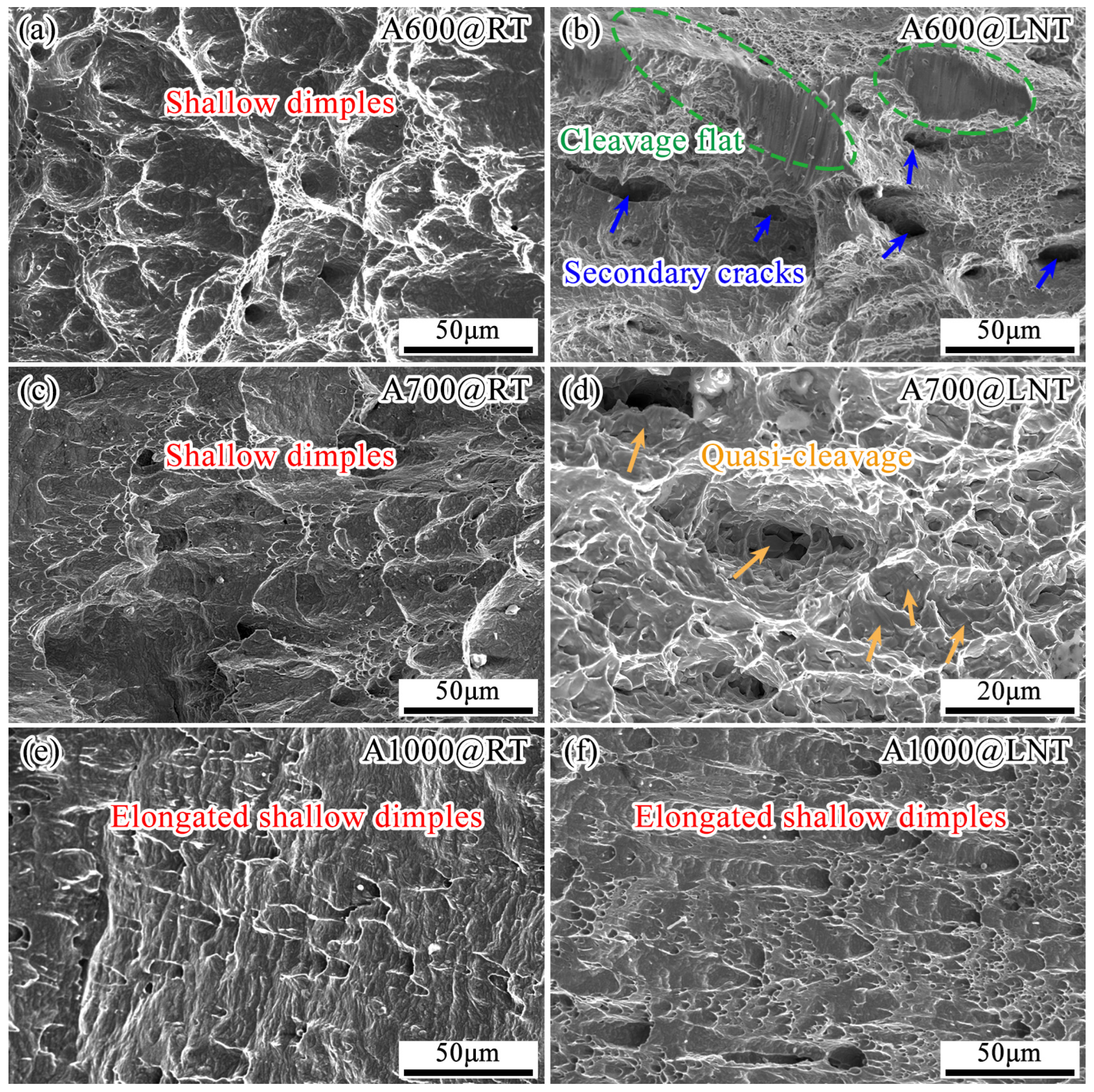

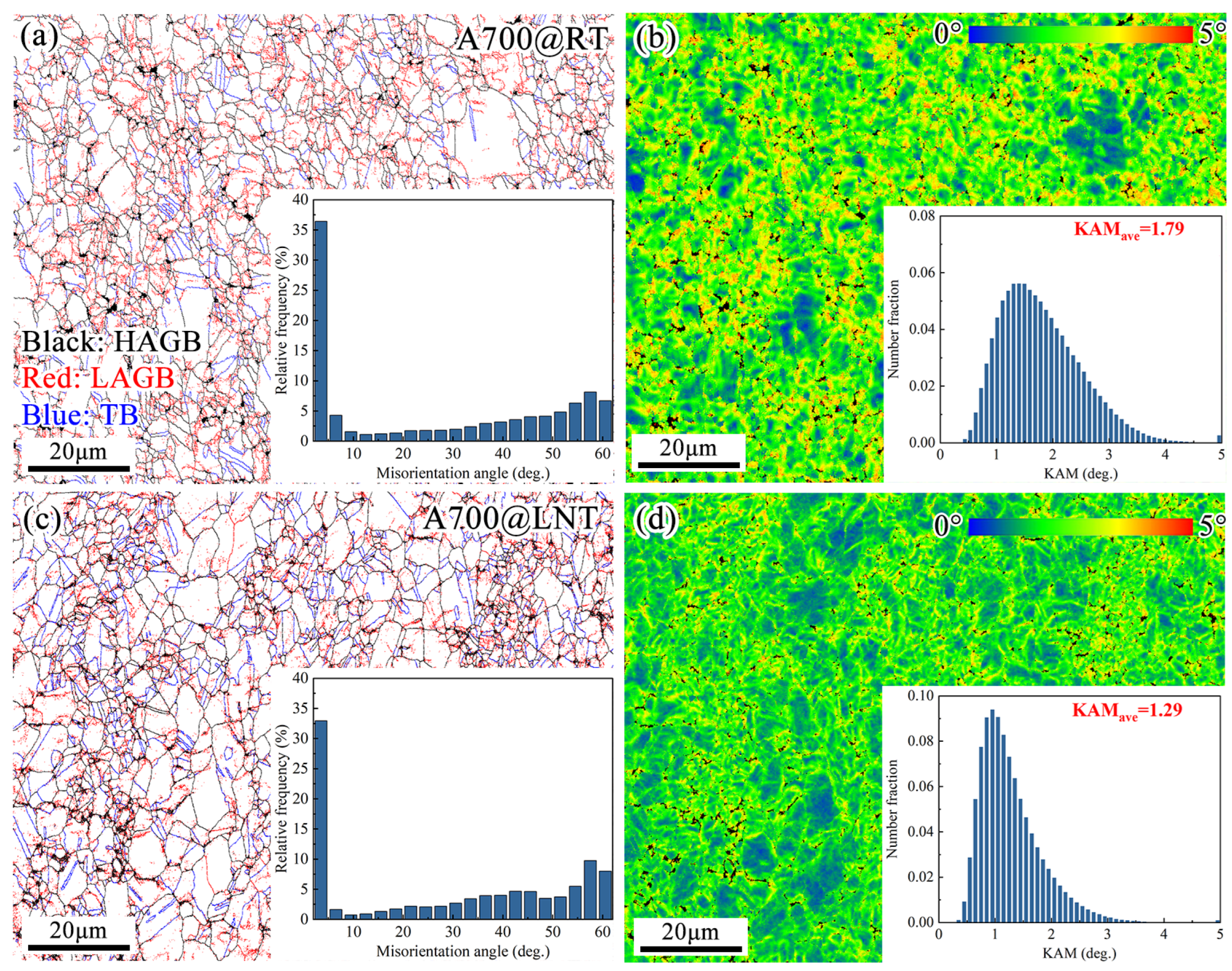
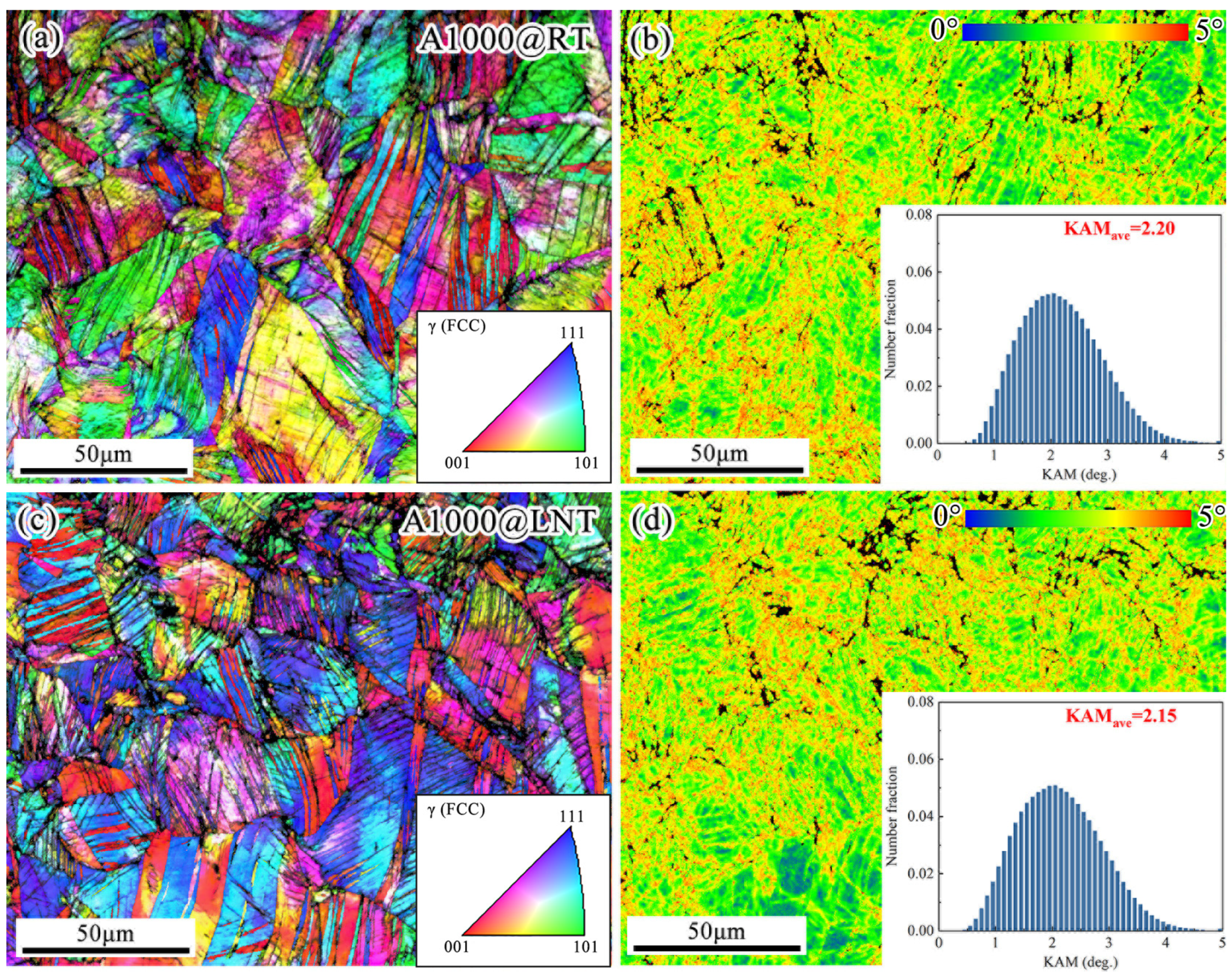
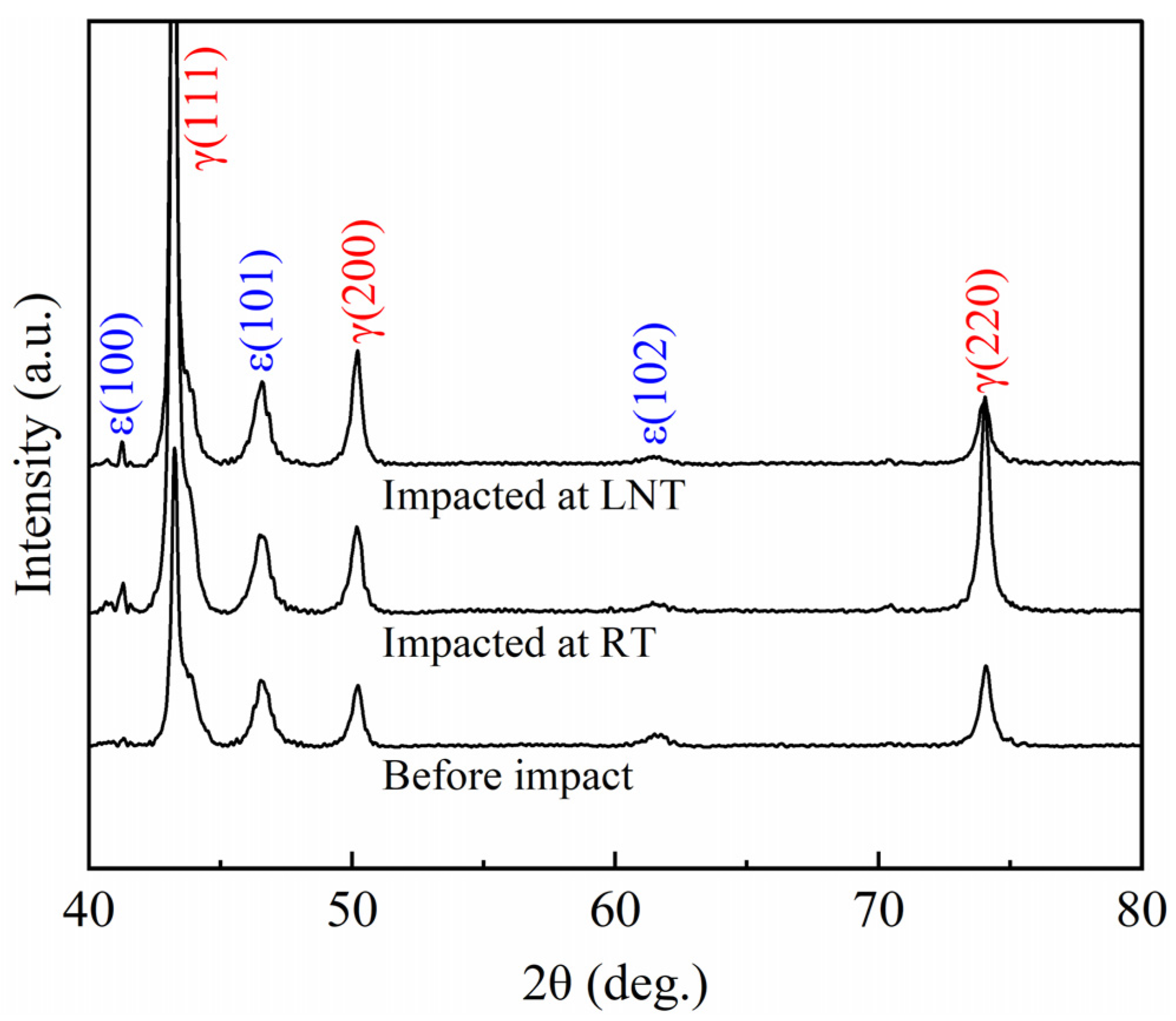
| Mn | C | S | Fe |
|---|---|---|---|
| 30.2 | 0.052 | 0.018 | Bal. |
| Specimen | YS/MPa | UTS/MPa | UE/% | TE/% | RT Cev/J | LNT Cev/J |
|---|---|---|---|---|---|---|
| CR | 1256 | 1470 | 2.0 | 7.0 | 26 | 14 |
| A550 | 1030 | 1085 | 5.8 | 13.0 | 171 | 36 |
| A600 | 582 | 760 | 29.3 | 43.1 | 228 | 81 |
| A700 | 430 | 699 | 40.3 | 51.7 | 278 | 172 |
| A1000 | 213 | 525 | 39.4 | 49.4 | 330 | 325 |
Disclaimer/Publisher’s Note: The statements, opinions and data contained in all publications are solely those of the individual author(s) and contributor(s) and not of MDPI and/or the editor(s). MDPI and/or the editor(s) disclaim responsibility for any injury to people or property resulting from any ideas, methods, instructions or products referred to in the content. |
© 2023 by the authors. Licensee MDPI, Basel, Switzerland. This article is an open access article distributed under the terms and conditions of the Creative Commons Attribution (CC BY) license (https://creativecommons.org/licenses/by/4.0/).
Share and Cite
Xiong, J.; Li, H.; Kong, L.; Zhang, X.; Cao, W.; Wang, Y. Dependence of Charpy Impact Properties of Fe-30Mn-0.05C Steel on Microstructure. Crystals 2023, 13, 353. https://doi.org/10.3390/cryst13020353
Xiong J, Li H, Kong L, Zhang X, Cao W, Wang Y. Dependence of Charpy Impact Properties of Fe-30Mn-0.05C Steel on Microstructure. Crystals. 2023; 13(2):353. https://doi.org/10.3390/cryst13020353
Chicago/Turabian StyleXiong, Jianchao, Heng Li, Ling Kong, Xiaodan Zhang, Wenquan Cao, and Yuhui Wang. 2023. "Dependence of Charpy Impact Properties of Fe-30Mn-0.05C Steel on Microstructure" Crystals 13, no. 2: 353. https://doi.org/10.3390/cryst13020353
APA StyleXiong, J., Li, H., Kong, L., Zhang, X., Cao, W., & Wang, Y. (2023). Dependence of Charpy Impact Properties of Fe-30Mn-0.05C Steel on Microstructure. Crystals, 13(2), 353. https://doi.org/10.3390/cryst13020353







